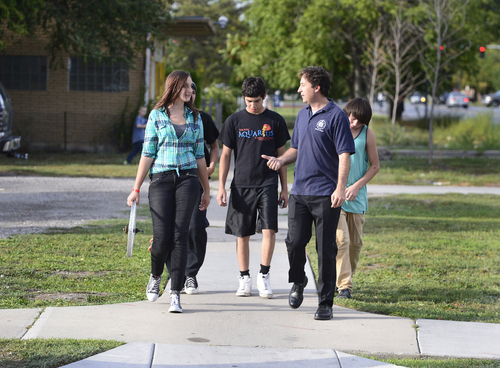This is an archived article that was published on sltrib.com in 2014, and information in the article may be outdated. It is provided only for personal research purposes and may not be reprinted.
Surrounded on three sides by freeways and railroad tracks, Salt Lake City's Poplar Grove and Glendale neighborhoods scored at the bottom of the federal "opportunity index"— but things could be different, according to the newly proposed West Side Master Plan.
Imagine riding a streetcar from the TRAX station at 200 West 900 South to the intersection of 900 South and 900 West, where a bustling neighborhood of cafes and shops stretches north to 800 South.
There you would find Latin American, African and Eastern European influences from food to clothing to art. Nearby bicycle traffic would flow east and west on the 9 Line, the abandoned rail right of way that parallels Indiana Avenue to Redwood Road. It intersects with Jordan River Parkway and a future nature preserve.
Pie in the sky? Maybe not. The master plan is an intended blueprint that would guide public and private development during the next 25 years.
The plan — in the works the past three years — is unusual in that it identifies "nodes" of activity, rather than large zones. The nodes distinguish intersections that would accommodate such things as regional commercial uses, neighborhood retail stores, recreation facilities and community activities. "We want to focus development so that it doesn't upset the balance of the single-family neighborhoods," said senior city planner Nick Britton.
But unlike other master plans, this one does not include a development map, Britton noted. The lack of hard, fast boundaries allows flexibility for would-be developers and business people.
Among the strategies for economic growth is more multifamily housing, Britton added. "More people will bring more commercial activity."
The west side is known for its ethnic diversity — the largest minority group being Latino. City officials, in conjunction with the nonprofit Comunidades Unidas, reached out to hundreds of west side residents asking what they would like to see in the master plan.
Luis Garza, the executive director of the organization, said residents wanted a host of things from more after-school activities for youths to better sidewalks and more retail shopping.
"It's been exciting for the community members to give feedback," he said. "It's empowering them."
Councilman Kyle LaMalfa, whose District 2 encompasses Poplar Grove and Glendale, said City Hall is eager to make improvements on the west side, particularly after becoming aware of a study by James Wood, director of the Bureau of Economic and Business Research at the University of Utah, in conjunction with the federal Department of Housing and Urban Development. The "opportunity index" study revealed the area to be the lowest in the city with an index of 1 to 2 on a scale where 10 is the highest score.
According to Wood, Salt Lake City's more-affluent neighborhoods score in the 9 to 10 range of the opportunity index, which is based on access to health care, education, transportation, jobs, and fresh fruits and vegetables, among other things.
Those west side communities have made great strides in recent years, but much is left to be done, Wood said. "It's a long-term effort that requires long-term resources."
By focusing on the area's key points, such as the Jordan River, the 9 Line, Redwood Road, 900 West and ethnic diversity, the west side can be transformed, LaMalfa said.
"It will act more like the rest of Salt Lake City," he said of the future. "But what it looks like — we are going to stay diverse. The character of the businesses here have to reflect the people who live here."
One of the keys to improving the area is more transportation connections to the rest of the city, LaMalfa said. Viaducts over the railroad tracks at 400 South, 1300 South and 2100 South are the main east-west links. "Every other possible way can leave you waiting for a Union Pacific train for 25 minutes," he said. The bridge at 1300 South will close next year for reconstruction, adding to the transportation challenges.
Longtime west-sider and community activist Archie Archuleta described the area as "a diamond in the rough."
He said little things, such as more street lighting and a general cleanup, will make a big difference. But he added that it would be nice to have a coffeehouse on Indiana Avenue.
Archuleta imagines the area surrounding 900 West and 900 South could be something like a west side version of the trendy setting at 900 East and 900 South.
He laments, however, that many plans for the west side have not come to fruition. Nonetheless, he hopes this master plan could be more successful.
"There has to be clarity," Archuleta said of urban planning. "And that only happens when you talk about it."
What's Next for West Side Master Plan
The City Council will review the plan at its 2 p.m. work session Sept. 30 at City Hall, 451 S. State.
The council will hold a public hearing at 7 p.m. Oct. 7 at Parkview Elementary, 970 S. Emery St. (1170 West).





